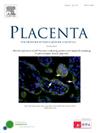妊娠期糖尿病发病前胎盘生长因子水平降低:胎盘功能障碍和内皮病理生理学的见解
IF 2.5
2区 医学
Q2 DEVELOPMENTAL BIOLOGY
引用次数: 0
摘要
目的妊娠期糖尿病(GDM)和先兆子痫(PE)是具有共同病理生理特征的产科并发症,涉及内皮功能障碍。先前的研究表明,GDM会增加PE的风险。虽然可溶性蛋白样酪氨酸激酶-1 (sFlt-1)和胎盘生长因子(PlGF)在PE中的作用已得到证实,但它们在GDM中的作用尚不清楚。为了解决这一差距,我们进行了一项回顾性队列研究,测量了GDM诊断前血清中sFlt-1、PlGF的水平及其比值。方法本研究分析了830例妊娠18 ~ 22周期间接受血清sFlt-1和PlGF检测的孕妇。GDM诊断在妊娠约22 - 28周期间进行,使用75g OGTT,并将患者分为GDM组和对照组。结果GDM组splgf水平显著低于对照组(中位数:231 vs 260 pg/mL, p = 0.05)。相反,GDM组与对照组在血清sFlt-1水平和sFlt-1/PlGF比值方面无统计学差异。这些发现提示PlGF可能在GDM病理生理中发挥重要作用,sFlt-1和PlGF之间的失衡可能在严重GDM中更为明显。本文章由计算机程序翻译,如有差异,请以英文原文为准。
Decreased placental growth factor levels precede the onset of gestational diabetes mellitus: Insights into placental dysfunction and endothelial pathophysiology
Aims
Gestational diabetes mellitus (GDM) and preeclampsia (PE) are obstetric complications that share common pathophysiological features involving endothelial dysfunction. Previous studies suggest that GDM increases PE risk. While the roles of soluble fms-like tyrosine kinase-1 (sFlt-1) and placental growth factor (PlGF) are well-established in PE, their involvement in GDM remains unclear. To address this gap, we conducted a retrospective cohort study measuring serum levels of sFlt-1, PlGF, and their ratio before the diagnosis of GDM.
Methods
This study analyzed 830 pregnant women who underwent serum sFlt-1 and PlGF measurements between 18 and 22 weeks of gestation. GDM diagnosis was performed between approximately 22 - 28 weeks of gestation using a 75g OGTT, and patients were classified into GDM and control groups.
Results
PlGF levels were significantly lower in the GDM group than in the control group (median values: 231 vs. 260 pg/mL, p = 0.05). Conversely, no statistically significant differences were observed between the GDM and control groups in terms of serum sFlt-1 levels and the sFlt-1/PlGF ratio.
Conclusions
These findings suggest that PlGF may play a crucial role in GDM pathophysiology and that an imbalance between sFlt-1 and PlGF may be more pronounced in severe GDM.
求助全文
通过发布文献求助,成功后即可免费获取论文全文。
去求助
来源期刊

Placenta
医学-发育生物学
CiteScore
6.30
自引率
10.50%
发文量
391
审稿时长
78 days
期刊介绍:
Placenta publishes high-quality original articles and invited topical reviews on all aspects of human and animal placentation, and the interactions between the mother, the placenta and fetal development. Topics covered include evolution, development, genetics and epigenetics, stem cells, metabolism, transport, immunology, pathology, pharmacology, cell and molecular biology, and developmental programming. The Editors welcome studies on implantation and the endometrium, comparative placentation, the uterine and umbilical circulations, the relationship between fetal and placental development, clinical aspects of altered placental development or function, the placental membranes, the influence of paternal factors on placental development or function, and the assessment of biomarkers of placental disorders.
 求助内容:
求助内容: 应助结果提醒方式:
应助结果提醒方式:


